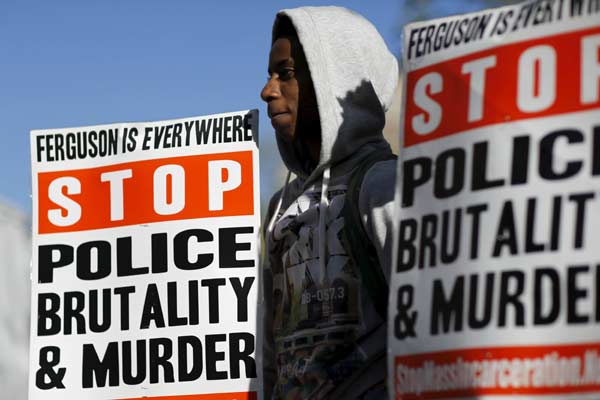Riot-hit Baltimore, an American city divided by income and opportunity
Updated: 2015-04-29 11:25
(Agencies)
|
|||||||||||
 |
|
A man holds placards while protesters gather to support Baltimore's protests against police brutality following the April 19 death of Freddie Gray in police custody, during a rally in New York April 28, 2015. [Photo/Agencies] |
Baltimore's economy has ticked up - traffic is rising at its port, which handles a lot of trade in automobiles among other things - and the unemployment rate has fallen to 8.4 percent in February, down about four percentage points over the past five years.
The city's population has started to stabilize in the last few years, following decades of white flight into the suburbs and a declining industrial base.
But for those who live in one of the areas where people clashed with police on Monday - the Sandtown-Winchester area of Baltimore with the 21217 zipcode - about one third of the people live in poverty, according to census data.
Across the city as a whole, the poverty rate is 24 percent.
A married couple with two children is currently classified by the federal government as impoverished if they earn less than $24,000 a year.
In Baltimore, African Americans make up about two-thirds of the city, one of the largest black populations in absolute and relative terms in cities in the United States. Nearly 90 percent of people in Sandtown-Winchester are black.
Of the zip code's residents older than 24, about 57 percent have not advanced beyond a high school education, 15 percentage points above the national average, according to census data. A third of the homes there are vacant.
By contrast, in the Roland Park 21210 zipcode on the more affluent north side of the city, the poverty rate is 10.2 percent. That zipcode is 80 percent white and more than 90 percent of people older than 24 have attended at least some college.
Related Stories
Obama says no excuse for Baltimore violence 2015-04-29 08:25
Riots erupt in Baltimore after funeral 2015-04-29 07:40
Baltimore erupts in riots after funeral of man who died in police custody 2015-04-28 23:59
Riot, looting prompt state of emergency, curfew in Baltimore 2015-04-28 09:52
Wake held in Baltimore for black man who died after arrest 2015-04-27 10:07
Today's Top News
Nepalis wait for quake help as death toll passes 4,000
61 suspects back home to be tried
PLA's Moscow debut confirmed
DPRK, Russia ink protocol after inter-governmental meeting
Belt and Road Initiative a boost to China, regional economy
China rescue team starts work in Nepal
At least 20 dead in Tibet following Nepal quake
Opinion: China leads in many high-speed rail aspects
Hot Topics
Lunar probe , China growth forecasts, Emission rules get tougher, China seen through 'colored lens', International board,
Editor's Picks

|

|

|

|

|

|






